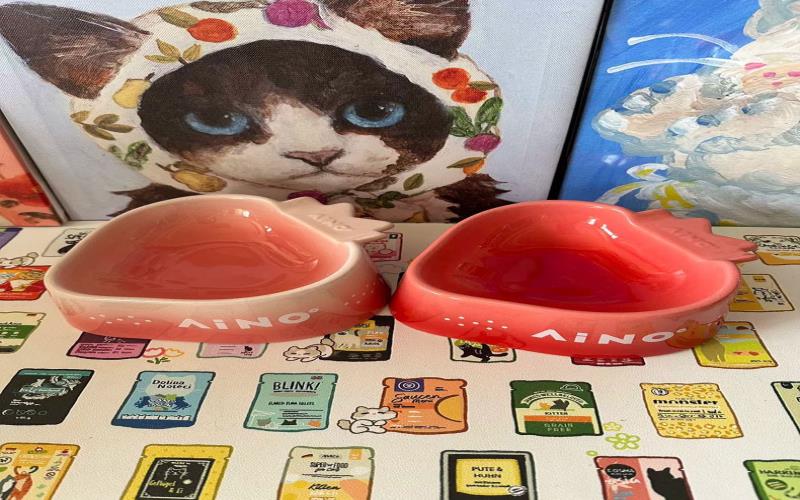As cat parents, we often put great effort into choosing the right food for our furry companions, but have you ever considered how important their bowl is? A cat bowl isn’t just a vessel for food and water—it plays a crucial role in your cat’s health, comfort, and overall happiness. Whether you have a picky eater, a messy drinker, or a senior cat with special needs, the right bowl can make a big difference.
In this blog, we’ll explore what to consider when choosing a cat bowl, the benefits of different designs, and tips for ensuring your feline friend enjoys every meal to the fullest.
Why Your Cat’s Bowl Matters
Cats are creatures of habit, and the way they eat and drink is influenced by their environment and tools. A poorly designed or unsuitable bowl can lead to discomfort, mess, or even health issues. For example:
- Whisker Fatigue: Cats’ whiskers are extremely sensitive. If their bowl is too deep or narrow, it may cause whisker fatigue, leading to stress and reluctance to eat or drink.
- Hygiene Concerns: Certain materials, like plastic, can harbor bacteria or absorb odors, which may deter your cat from using their bowl.
- Feeding Position: The wrong bowl height can cause strain on your cat’s neck and back, especially for senior cats or those with arthritis.
Choosing the right bowl can help address these issues and make mealtime a pleasant experience.
Types of Cat Bowls
When selecting a cat bowl, it’s essential to consider your cat’s size, eating habits, and preferences. Here’s a breakdown of the most common types of cat bowls and their benefits:
Shallow Bowls
Ideal for cats with flat faces, like Persians, or cats who dislike their whiskers touching the sides of the bowl. Shallow bowls prevent whisker fatigue and make it easier for cats to access food.
Elevated Bowls
Elevated bowls are raised off the ground to create a more comfortable eating position. These are particularly beneficial for senior cats or those with joint or mobility issues, as they reduce strain on the neck and back.
Slow-Feeder Bowls
Designed with ridges or mazes, slow-feeder bowls help prevent cats from eating too quickly. This is especially useful for cats prone to vomiting or digestion issues.
Ceramic or Stainless-Steel Bowls
These materials are highly durable, non-porous, and easy to clean, making them the best choice for hygiene. Ceramic bowls often come in stylish designs, while stainless steel is lightweight and practical.
Automatic Feeders
If you have a busy schedule, automatic feeders can help regulate your cat’s feeding times and portion sizes. Many modern options even have features like timers and smartphone controls.
Water Fountains
While technically not a bowl, water fountains are a fantastic option for cats who prefer fresh, running water. They encourage hydration, which is especially important for cats prone to urinary or kidney issues.
How to Choose the Best Cat Bowl
When shopping for a cat bowl, keep the following factors in mind:
Material
-
- Ceramic: Sturdy and stylish, but prone to chipping if dropped. Look for lead-free, food-safe options.
- Stainless Steel: Durable, lightweight, and easy to clean. Avoid bowls with painted designs that may chip over time.
- Plastic: Lightweight and affordable, but less durable and more prone to scratching, which can trap bacteria.
Size and Depth
Choose a bowl that matches your cat’s size and face shape. For large cats, opt for a wider bowl to ensure they can eat comfortably.
Stability
Cats can be surprisingly energetic eaters, so look for bowls with a non-slip base or some weight to prevent tipping or sliding.
Ease of Cleaning
A dishwasher-safe bowl can save time and ensure thorough cleaning. Clean your cat’s bowl daily to prevent bacteria buildup.
Design and Aesthetics
While functionality is key, you don’t have to sacrifice style. Many modern cat bowls come in sleek, minimalist designs that blend seamlessly with your home décor.
Tips for Mealtime Success
- Keep Bowls Separate: Cats are territorial, and some prefer to have their food and water bowls in separate locations.
- Fresh Water Daily: Hydration is essential for your cat’s health, so always provide clean, fresh water.
- Portion Control: Use the right-sized bowl to help manage portion sizes and prevent overeating.
- Monitor Behavior: Pay attention to how your cat interacts with their bowl. If they seem hesitant to eat or drink, it might be time to try a different type of bowl.
The Benefits of Investing in a Good Cat Bowl
Improved Eating Habits
The right bowl can encourage your cat to eat at a healthy pace and reduce issues like vomiting or overeating.
Better Hygiene
High-quality materials and easy-to-clean designs help keep bacteria at bay, ensuring your cat’s health and safety.
Enhanced Comfort
From reducing whisker fatigue to minimizing joint strain, a well-chosen bowl makes mealtime more enjoyable for your cat.
Peace of Mind for You
Knowing your cat is comfortable, happy, and well-fed allows you to focus on the joys of pet parenting.
Conclusion
Choosing the right cat bowl might seem like a small detail, but it’s a big part of your cat’s daily life. By considering your cat’s unique needs and preferences, you can find a bowl that enhances their comfort and well-being.
At MEWCATS, we’re passionate about helping cat parents create the best environment for their furry friends. Whether it’s finding the perfect bowl or understanding your cat’s habits, we’re here to make life better for you and your beloved feline.

